Tracking the right SEO KPIs is essential for enterprise success. Not only do these metrics reveal whether your search engine optimization strategies are effective, but they also guide future improvements by highlighting past successes and mistakes.
Yet, many SEOs struggle with reporting, often unsure which KPIs to focus on or finding that their efforts yield little actionable insight.
To help, I've compiled a list of the critical KPIs every enterprise SEO should track. These metrics will not only enhance your strategic outcomes but also help demonstrate the value your SEO efforts deliver to your organization.
Table of Contents:
- What Are SEO Key Performance Indicators?
- What Are the Benefits of Tracking SEO KPIs?
- How to Choose Which KPIs to Track
- The Most Important SEO Key Performance Indicators
- Secondary SEO Key Performance Indicators
- How to Track All SEO KPIs Efficiently
What Are SEO Key Performance Indicators?
Key Performance Indicators (KPIs) are metrics that reflect how effectively a company, team, or business unit is achieving its key objectives.
In the context of SEO, KPIs are specific metrics that demonstrate how your search engine optimization efforts are contributing to the company's goals. They help you assess the impact of your SEO strategies and determine if you are effectively driving results.
What Are the Benefits of Tracking SEO KPIs?
SEOs ask me this question often. They want to know why they should put the effort into a.) identifying the best metrics to track, and b.) setting up dashboards and reporting to monitor them.
I have three reasons:
- Clarity of Efforts: KPIs provide clear insights into your strategy’s performance, highlighting its strengths, weaknesses, and missed opportunities. This data-driven approach helps you refine and optimize your efforts.
- Increased Focus: By focusing on the right metrics, you avoid distractions and concentrate on areas that need immediate attention. This focus ensures you prioritize actions that drive the most significant results.
- Revealing True Value: KPIs demonstrate the real impact of your SEO efforts, helping you identify successes and areas for improvement.
(A quick side note: If you work on an enterprise-size website, consider using an enterprise SEO platform. It offers multi-metric tracking functionality to determine SEO success, simplifying KPI reporting in the process.)
How to Choose Which KPIs to Track
With so many options, like rankings, traffic, revenue, goals, bot activity, and site audit changes, it can be challenging to decide which SEO KPIs to focus on.
The key is to align your KPIs with your company’s or team’s overarching goals.
To make this easier, I've categorized the most important SEO KPIs into two groups: primary and secondary.
-
Primary KPIs: These metrics reveal the success rate of your SEO efforts. They are crucial for internal reporting and for demonstrating results to stakeholders.
-
Secondary KPIs: These metrics show the value SEO delivers to the organization. They help illustrate how SEO contributes to achieving the company’s broader objectives.
Tracking these KPIs separately is important because they serve different reporting needs. Let's start by going over the primary SEO KPIs.
The Most Important SEO Key Performance Indicators
The primary KPIs to track for SEO include:
Below, we'll dive into each of these KPIs in more detail.
1. Organic Traffic
Organic traffic is a critical KPI for SEO because it measures the number of visitors who find your website through unpaid search engine results, reflecting the effectiveness of your SEO strategies.
It indicates how visible and relevant your site is in search engine rankings, helping you understand the impact of your keyword optimization, content quality, and link-building efforts.
Plus, organic traffic typically consists of high-quality users who are actively searching for information or products related to your business. This results in higher engagement and conversion potential, offering a sustainable path for long-term growth.
How to Track and Analyze Organic Traffic
With Site Analytics in seoClarity, you can track and analyze organic traffic changes in multiple different ways. Here are some options:
Traffic By Date: Set a specific date range to effectively monitor organic traffic changes after launching a new campaign or updating your website.
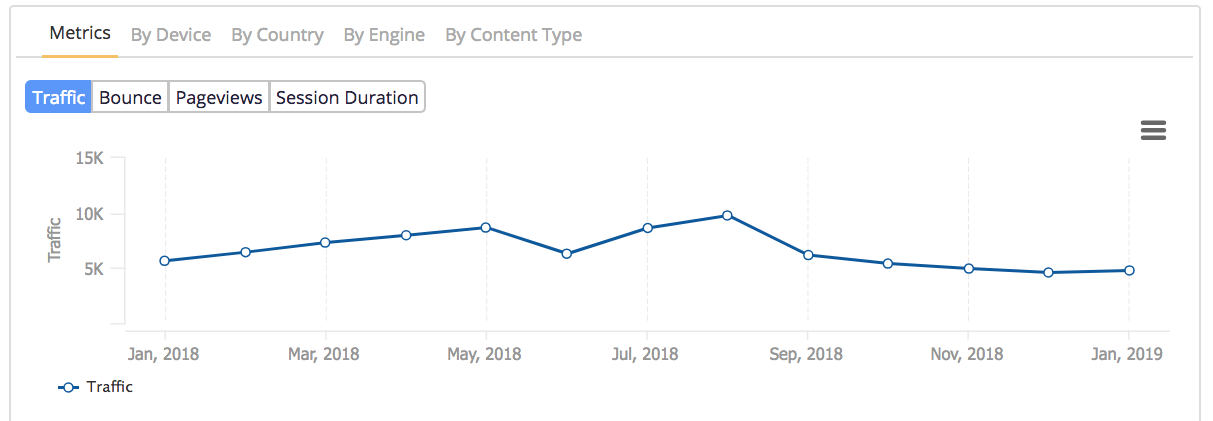
(Site Analytics report in seoClarity)
Branded vs. Non-Branded Traffic: Use the Traffic by Search Intent analysis to differentiate between branded and non-branded traffic, helping you understand how your brand presence and keyword targeting are performing.
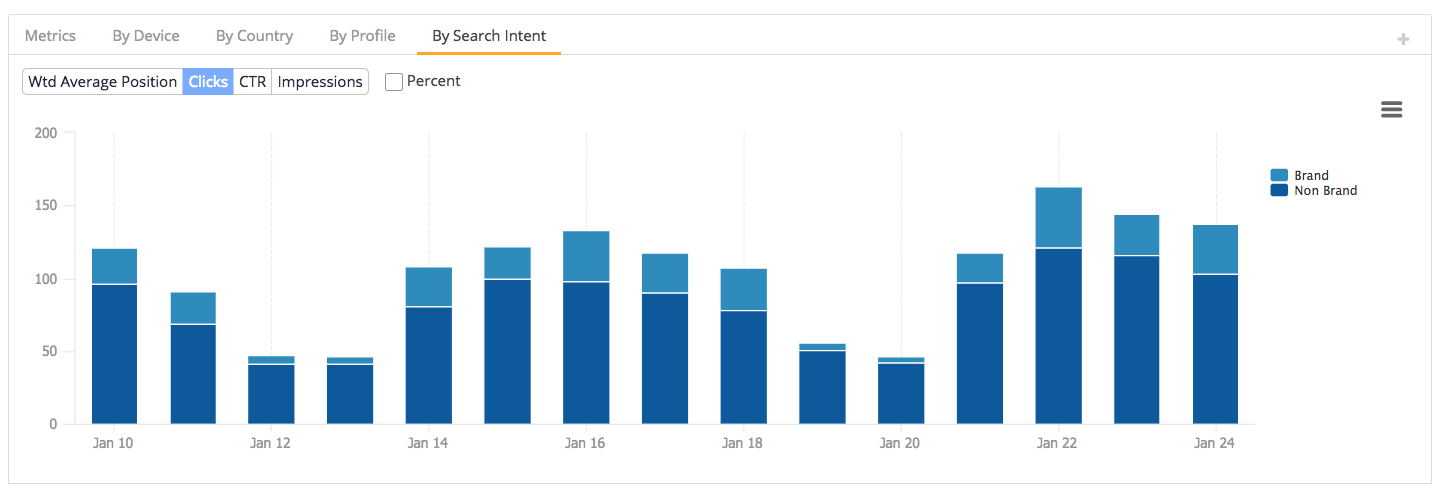
(Traffic by Search Intent analysis)
Year-Over-Year Performance: Utilize the YoY traffic comparison report to evaluate your organic search performance over time, identifying growth trends and seasonal patterns.
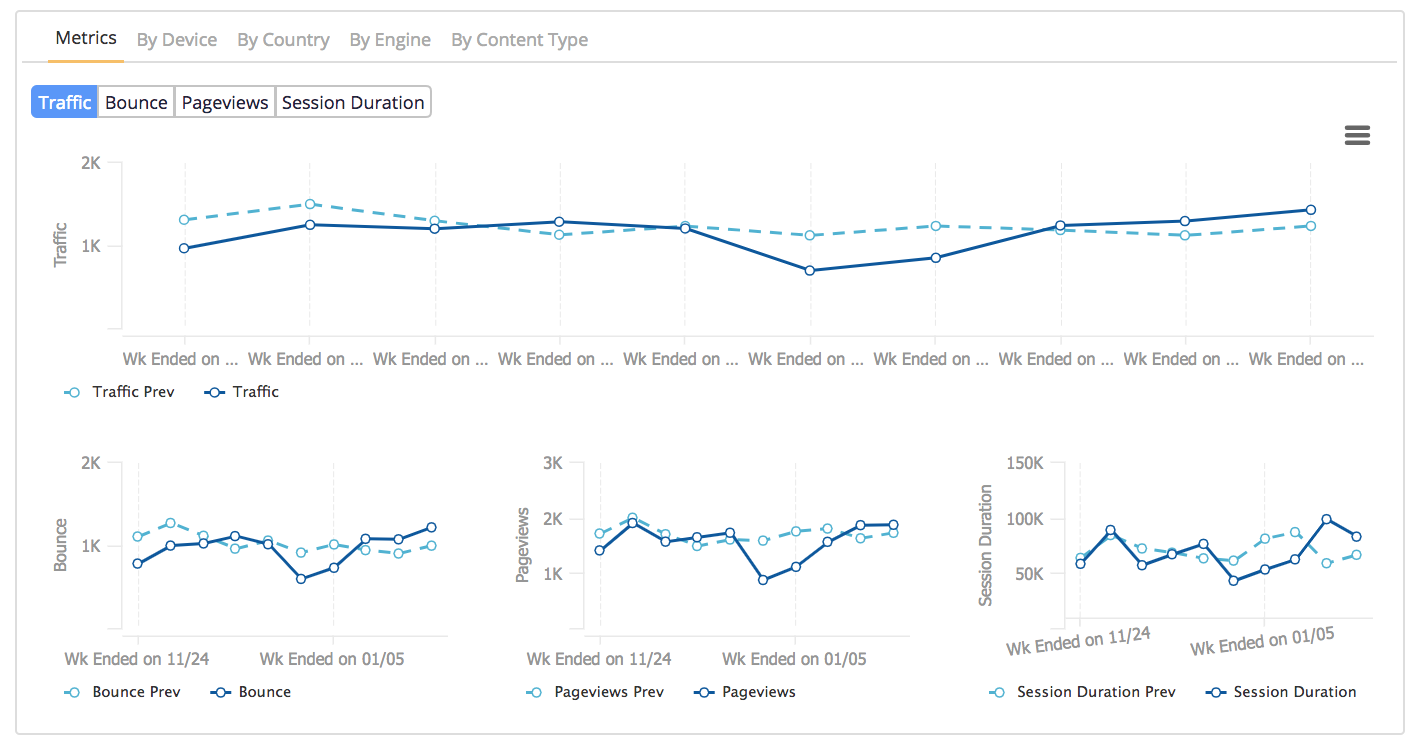
(YoY traffic comparison report)
Traffic by Website Section: Access the Traffic filtered by website section report to see how different areas of your site, such as the homepage and product pages, are performing in attracting organic traffic.

(Traffic filtered by website section report)
Traffic Engagement Metrics: Analyze engagement factors like bounce rate, session duration, and time on page to gain insights into how well your content is engaging visitors and retaining their interest.

(Year over year pageviews report to a specific page on the site.)
2. Number of Pages Driving Traffic
Not every page on your website will attract visitors; some pages may lack visibility in SERPs, while others may cover topics with low audience interest. However, your goal should be to create as many traffic-generating assets as possible.
To demonstrate the effectiveness of your efforts, track the change in the number of pages driving traffic since you began optimizing the site. This will help you identify which pages are successfully engaging users and contributing to your overall traffic growth.
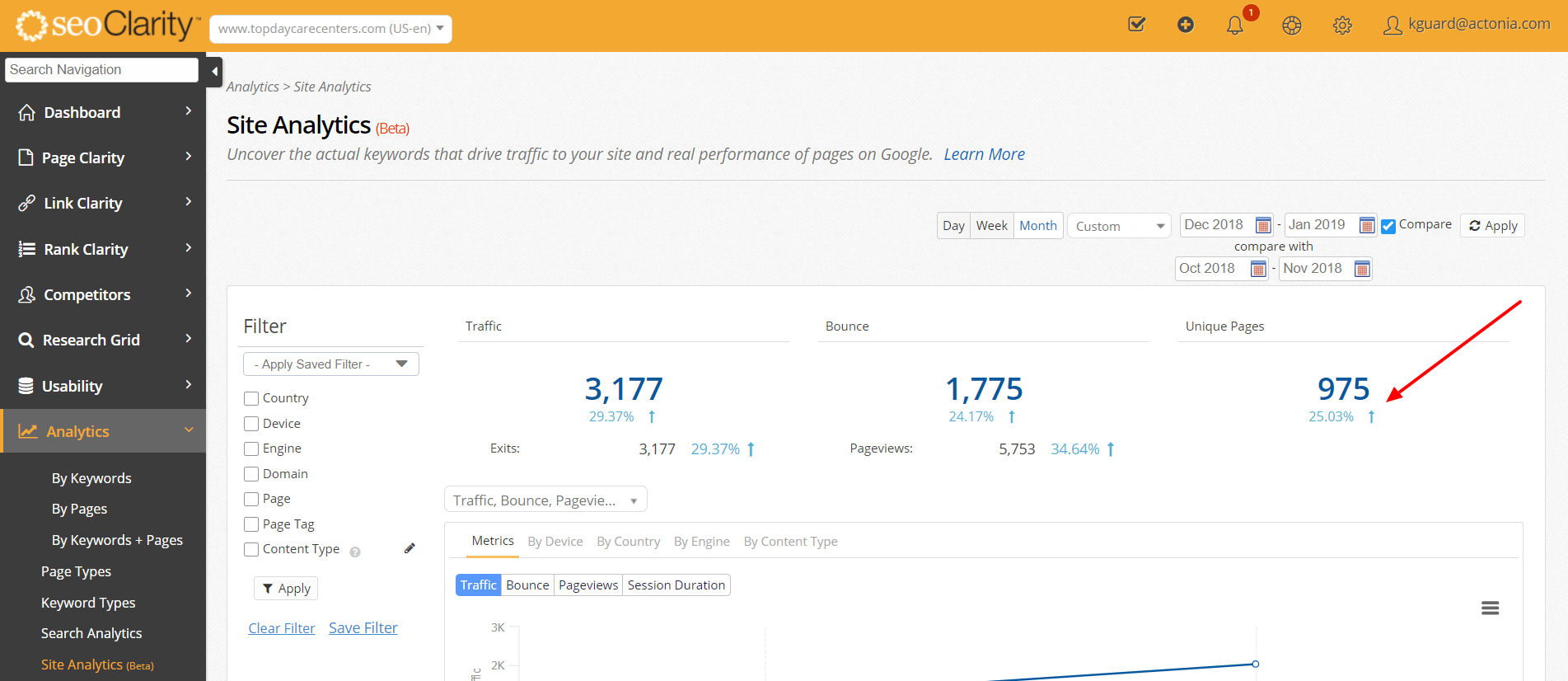
3. Google Analytics Goals
If you’ve set up goals in Google Analytics, it's essential to closely monitor how well your SEO efforts help achieve them.
Site Analytics allows you to analyze all your GA goals and correlate this data with other SEO metrics, such as rankings, bot activity, page issues, and Search Console keywords.
This comprehensive analysis helps you understand the impact of your SEO strategies on your business objectives and make data-driven decisions to optimize performance.
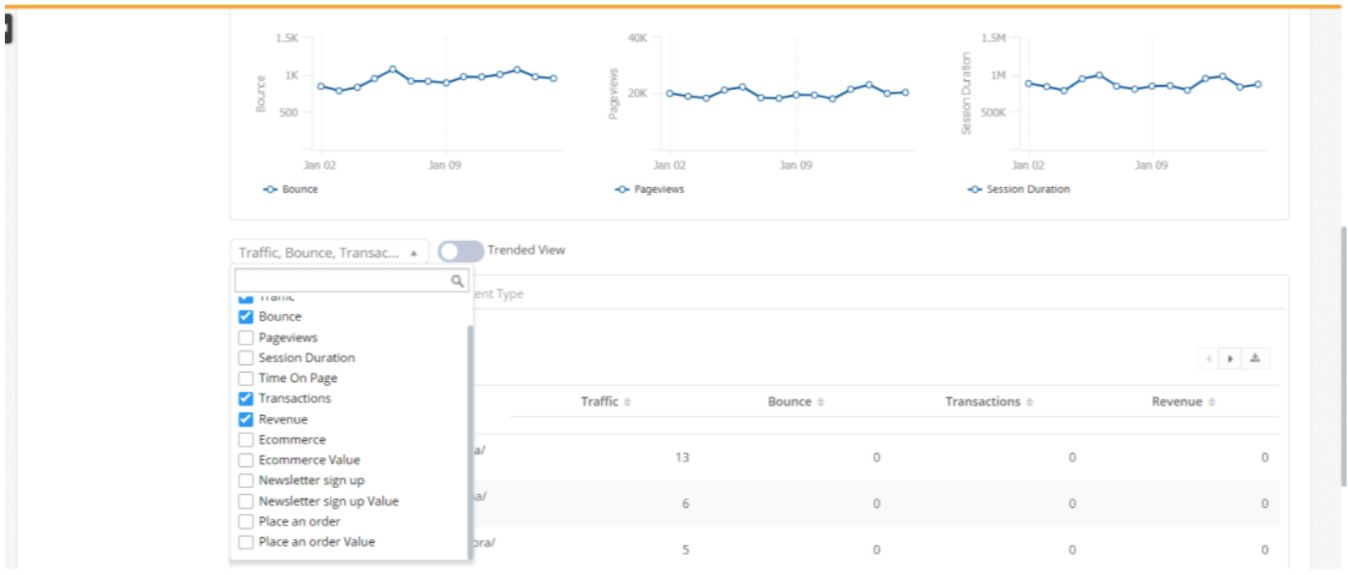
(Goals report in Site Analytics)
4. Backlink Profile Growth
High-quality backlinks indicate popularity, trust, and authority, all of which contribute to improved search rankings.
Therefore, it's crucial to monitor the number of new backlinks your content attracts and track the overall growth of your link profile. This will help you assess the effectiveness of your link-building strategies and identify opportunities to further enhance your site's authority and visibility.
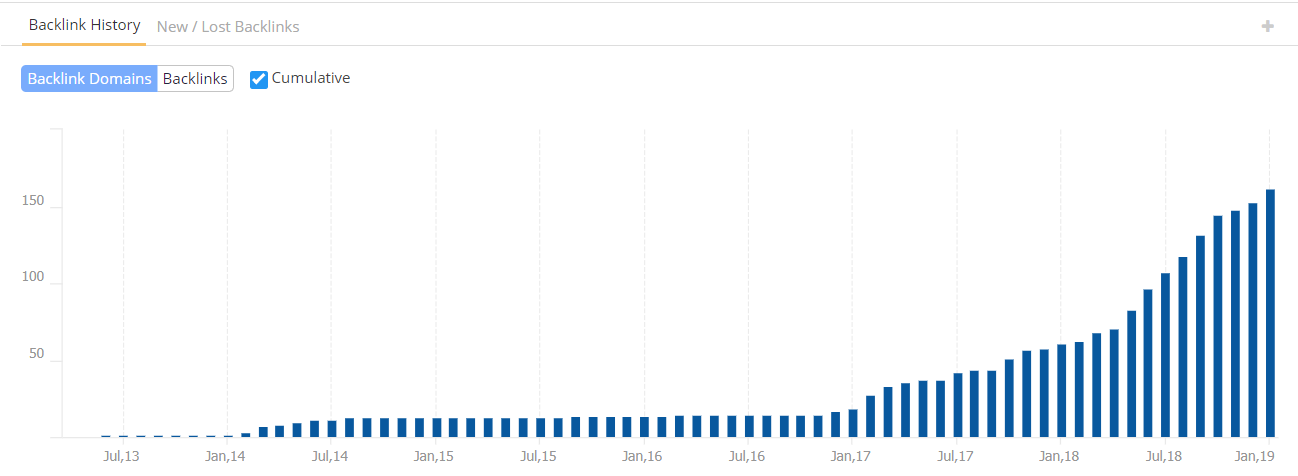
(Backlink history report in seoClarity)
5. Site Issues & Crawlability
Technical aspects of your site can significantly impact SEO, so it's important to track how effectively you address site issues and improve crawlability.
While you don't need to review this information daily, I recommend checking this KPI weekly to monitor changes and ensure that your site remains accessible and optimized for search engines.
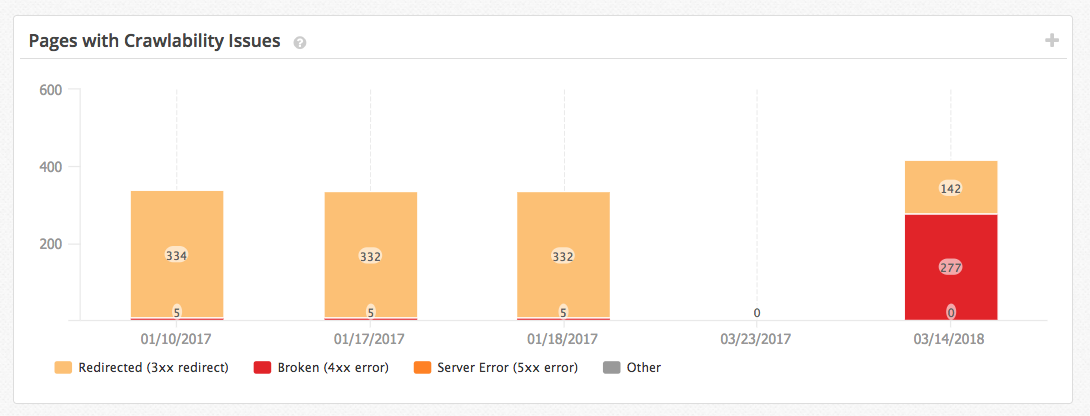
(Crawlability issues historic trend data)
6. Page Speed
Google prioritizes websites that load quickly because they offer a superior user experience and immediate access to information.
A fast-loading website also boosts conversion rates. If a page loads slowly, users are more likely to return to the SERP and choose a different site.
Therefore, page speed is one of the most critical factors affecting SEO success. This is why tracking and monitoring page speed is essential as an SEO KPI.
7. Indexed Pages
Tracking your indexed pages is a critical SEO KPI because unindexed pages can mean missing out on significant opportunities, particularly if those pages are crucial to your website's success.
Many believe that submitting a page to Google for indexing ensures it will be indexed automatically, but this is not the case. When you submit a page, Google treats it as a suggestion and is not obligated to index it.
To ensure your pages are indexed correctly, submit your sitemap via Google Search Console and verify that your important pages are not blocked by robots.txt files.
Proper technical optimization of your site is foundational for SEO performance and success. Ensure your site is optimized to drive organic traffic by using our SEO audit checklist.
8. Bounce Rate
A website bounce rate is one of the most undervalued metrics of any successful SEO campaign. Bounce rate is the number of visitors that navigate away from the site after viewing only one page.
You want to track this SEO KPI because it illustrates your site visitor’s journey from clicking on your link to which paths they take once they land on a page. If visitors keep leaving after only a few seconds from the initial landing page, it demonstrates that something is not resonating.
One of the most common errors is simply unclarified information in your ad or meta description. If visitors expect to find something based on your description but realize it isn't offered once they arrive, they'll quickly leave your site.
To prevent this, ensure that your ad copy and meta descriptions accurately reflect your offerings and are easy to understand. Additionally, evaluate your content and web design to ensure they align with user expectations.
9. Conversion Rate
Organic traffic is valuable, but if it doesn’t convert, it doesn’t contribute to your ultimate goals.
That's why tracking your conversion rate is a crucial SEO KPI. It helps you measure how effectively your site turns visitors into customers or leads, ensuring that your SEO efforts are driving meaningful results.
First, identify the pages with low conversion rates, and then answer the following questions from an end-user perspective.
- Is your site easy to navigate?
- Do you use simple call-to-action statements?
- Does your site have a one-step conversion process that makes it easy for end users to reach the ultimate end goal (e.g., a brochure download, purchase, sign-up, etc)?
- Does your page load fast enough?
- Is your site mobile-friendly?
- Does your site have content that meets the needs of end users, and is your content valuable?
If the answer to any of those questions is “no,” you need to take a closer look at your website content and SEO strategy and make some changes.
10. Keyword Rankings
How your site ranks for your target kewywords also indicates the effectiveness of your SEO strategy. High rankings increase visibility and typically drive more organic traffic to your site, ultimately leading to greater engagement and conversions.
By understanding which keywords you rank well for and which need more focus, you can refine your content strategy to better align with user intent and search trends.
With the help of seoClarity Rank Intelligence, you can explore your site's keyword rankings, and manage keywords in real-time.
Secondary SEO Key Performance Indicators
Now let's move onto the secondary SEO KPIs to track. As previously stated, these KPIs demonstrate SEO's contribution to the company's goals.
1. Repeat Visits or Branded Visits
Repeat visits to your site often signifies increased brand awareness from a business perspective. Similarly, visitors entering the site through branded keywords also demonstrate familiarity with your brand.
If your company aims to boost brand awareness, tracking and reporting on these two metrics can help demonstrate SEO’s contribution to achieving this goal.
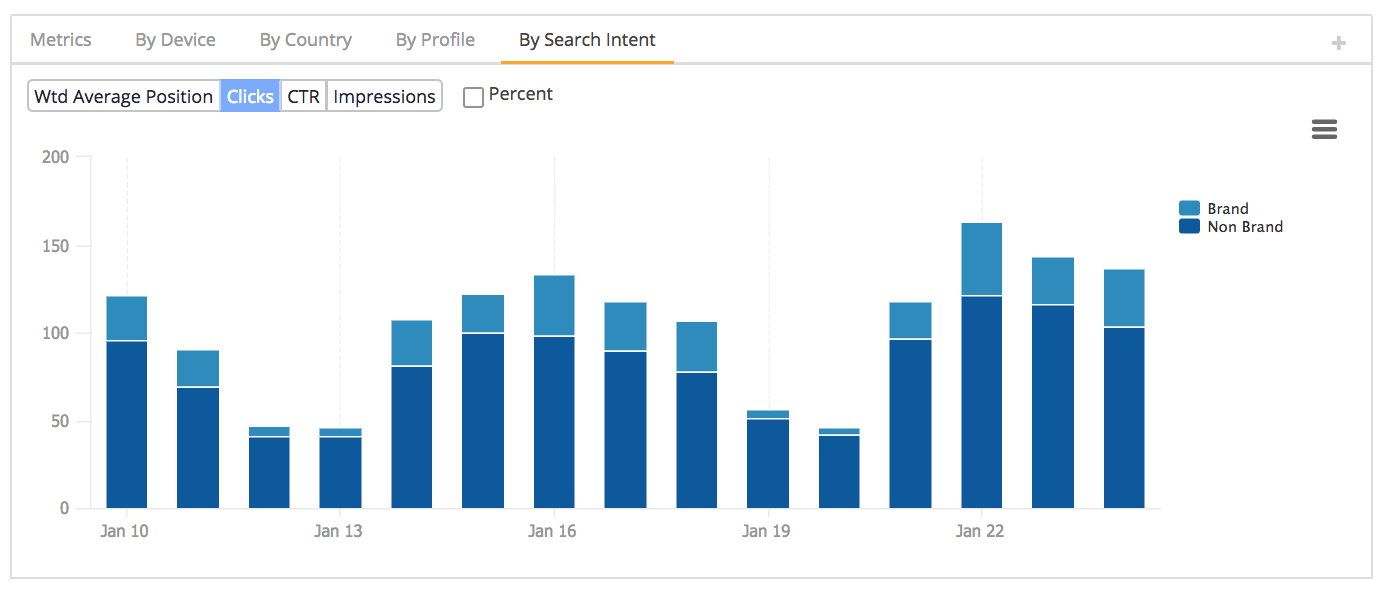
(Branded visits report)
2. Tangible Results from the Organic Channel
Defining tangible results from the organic channel can vary by organization, as each may have specific goals such as sales, bookings, inquiries, sales-ready leads, or demo requests.
It’s crucial to identify and track the metric that aligns with your business objectives. For many organizations, this KPI is essential, as it provides concrete evidence that your SEO strategies are helping the company achieve its goals.
If revenue is your key metric, consider tracking earnings by device type, especially with the mobile-first index. This approach provides valuable insights into your audience’s preferences and helps you tailor your strategies accordingly.
How to Track All SEO KPIs Efficiently
With so many KPIs to track, how do you ensure reviewing them doesn't consume too much of your time?
The answer is to create an SEO dashboard that consolidates all the metrics you need in one place. This approach is surprisingly simple. For instance, seoClarity allows you to set up a comprehensive dashboard in just a few clicks, especially if you use one of our templates.
Intrigued? Learn more about the platform here or schedule a demo today!
<<Editor's Note: this post was originally published in February 2019 and has since been updated.>>








Comments
Currently, there are no comments. Be the first to post one!